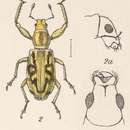Physical description
provided by INOTAXA archive
This genus appears to have its headquarters in Mexico, whence a large number of species are now described, extending northward into the United States and southward into the Windward Is., Colombia, &c. The type is the N.-American P. hilaris, Herbst (= pauperculus, Gyll.). It is connected with Hadromerus by P. erubescens, mainly differing from that genus by the less approximate anterior coxæ. The species here referred to Pandeleteius have a 7-jointed funiculus, very stout anterior femora, and denticulate anterior tibiæ*. The vibrissæ are not visible in one or two of the smaller forms (as already noted by Schaeffer), but they may be abraded or represented by small scales; and the scrobes vary in length, according to the species. Those with a deep transverse inter-antennal sulcus on the rostrum, or a long second joint to the funiculus, might perhaps be eliminated, but they are connected by intermediate forms. Menetypus (type, M. hadromeroides, Kirsch, from Colombia) only differs from Pandeleteius in the wide sense in having rather more sharply denticulate anterior tibiæ†. The females of several species have the elytral suture set with long erect hairs or setæ towards the apex (as in Hadromerus), and in P. armatus there is also a sharp oblique tooth on its inner edge near the tip. The wings seem to be fully developed in all of them.* P. rotundicollis, Fall, has a 6-jointed funiculus, and P. ovipennis and P. submetallicus, Schaeff., differ in various ways from the genus as here understood.
† An allied unnamed Colombian genus has simple anterior tibiæ.
- license
- cc-by-3.0
- copyright
- Biologia Centrali-Americana
Physical description
provided by INOTAXA archive
Since the remarks on the species of this genus were published (anteà, p. 186), Mr. Schaeffer has kindly given us specimens of his P. cavirostris and ovipennis, from Brownsville, Texas, and P. robustus from the Huachuca Mts., Arizona, and also P. rotundicollis, Fall, from Cloudcroft, New Mexico. P. cavirostris (as already stated) =Polydacrys depressifrons, Boh.; P. robustus* is related to P. hirtipes; P. ovipennis has the elytra very little wider than the prothorax at the base, and comes near P. inflatus, though very much smaller than that insect; P. rotundicollis has a 6-jointed funiculus, but otherwise generally resembles P. vitticollis. According to Mitchell and Pierce [Proc. Ent. Soc. Wash. xiii. p. 49 (1911)], P. cavirostris is found on Ehretia elliptica (Boragineæ) and Cratægus (Rosaceæ).* The insect sent me by the U. S. Nat. Museum under this name (det. Pierce) (mentioned under P. vitticollis on p. 202, anteà) was wrongly identified. It has a 6-jointed funiculus and comes near P. rotundicollis.
Champion in: David Sharp & G. C. Champion, Dec. 1911. Biol. Centr.-Amer.,Coleoptera, vol. 4, pt. 3, Supplement: 343.
- license
- cc-by-3.0
- copyright
- Biologia Centrali-Americana
Pandeleteius: Brief Summary
provided by wikipedia EN
Pandeleteius is a genus of broad-nosed weevils in the family Curculionidae. There are over 150 described species in Pandeleteius, distributed across the Americas. Most species in the genus were described by Anne Howden.
- license
- cc-by-sa-3.0
- copyright
- Wikipedia authors and editors

